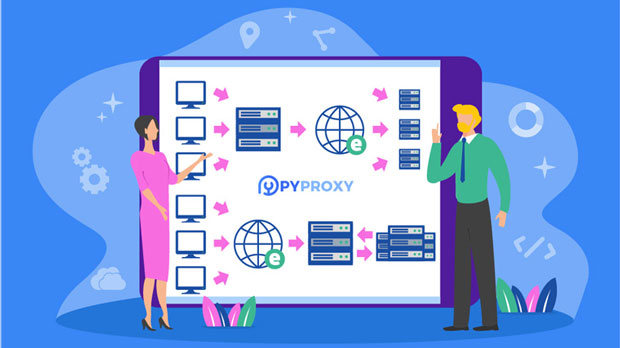socks5 proxy servers offer a flexible and secure way to route traffic through a network, making them popular for users seeking privacy, data security, and bypassing geographical restrictions. Accessing and configuring a socks5 proxy server programmatically through an API can streamline the process, especially for developers and businesses that need to automate proxy setup or manage multiple connections at scale. This article explores the steps for retrieving and configuring a SOCKS5 proxy server via API, providing a clear and practical guide for users interested in setting up socks5 proxies efficiently through automation. Understanding SOCKS5 Proxy ServersBefore diving into the API process, it's essential to understand what a SOCKS5 proxy is and why it's commonly used. SOCKS5 is the latest version of the SOCKS (Socket Secure) protocol, which facilitates the transmission of data between a client and a server through a proxy. Unlike traditional HTTP proxies, SOCKS5 can handle various types of internet traffic, including HTTP, FTP, and peer-to-peer, making it more versatile.The SOCKS5 protocol supports authentication, meaning that only authorized users can access the proxy, enhancing security. It also enables users to disguise their IP address and encrypt their traffic, offering anonymity for browsing, scraping, or handling sensitive data. This makes SOCKS5 proxies valuable for various use cases, including privacy-focused browsing, accessing geo-restricted content, or managing multiple online accounts without exposing the user's real IP address.Why Use an API to Retrieve and Configure SOCKS5 Proxies?APIs, or Application Programming Interfaces, allow software to interact with other applications, services, or systems. In the context of SOCKS5 proxies, APIs provide a powerful method for programmatically managing proxies at scale. With APIs, businesses or developers can automate the process of retrieving, configuring, and rotating SOCKS5 proxies without needing to manually intervene, which is particularly beneficial for large-scale operations like web scraping, social media management, or secure browsing.Some advantages of using an API to handle SOCKS5 proxies include:- Automation: Automatically retrieving and configuring proxies based on your requirements.- Scalability: Managing hundreds or thousands of proxies efficiently with minimal manual input.- Security: Setting up authentication and secure connections through the API.- Flexibility: Customizing proxy configurations to suit various use cases, such as rotating IPs or specifying certain geographical regions.Steps to Retrieve and Configure SOCKS5 Proxy Servers via APINow, let’s walk through the steps needed to retrieve and configure a SOCKS5 proxy server using an API.1. Select a Service That Provides SOCKS5 Proxy API AccessThe first step is selecting a service that offers API access to SOCKS5 proxies. These services allow developers to create and manage proxies programmatically. Generally, these services provide a set of endpoints, including ones to retrieve proxy lists, configure settings, and rotate proxies. Ensure that the service you choose supports API integration with SOCKS5 protocol.2. Obtain API CredentialsTo access the API, you will need authentication credentials, typically an API key or client ID. These credentials authenticate your application, ensuring that only authorized users can access the proxy servers. Typically, you will need to sign up for the service, create an account, and generate your unique API credentials.Once obtained, store these credentials securely, as they will be needed in the API request headers or payload.3. Retrieve a List of Available SOCKS5 ProxiesWith your credentials in hand, you can use the API to retrieve a list of available SOCKS5 proxy servers. Most APIs will allow you to query proxy lists based on various criteria such as:- Location: Choose proxies from specific regions or countries.- Authentication: Retrieve proxies that require authentication or are open.- Rotation settings: Define whether the proxies should rotate at set intervals.The API typically returns a list of proxies with IP addresses, ports, and other configuration details such as username and password if authentication is required.4. Configure Proxy SettingsOnce you have a list of available proxies, you can configure them according to your needs. This step involves sending a request to the API to configure the proxy's settings, such as IP address rotation, proxy expiration time, and the type of traffic the proxy should handle.Some of the key configuration options include:- Authentication setup: You can set up or enable authentication using a username and password to ensure that only authorized users can access the proxy.- IP rotation settings: For anonymity or to avoid detection, it’s often necessary to rotate IP addresses periodically. This feature is essential for applications like web scraping or data extraction.- Geolocation: If your use case requires proxies from a specific region or country, this can be specified through the API request.At this point, you may also configure the connection type (e.g., SOCKS5 vs. SOCKS4), set connection timeouts, and adjust performance parameters depending on the service you're using.5. Test the Proxy ServerOnce you have configured the proxy settings, it’s important to test whether the proxy is functioning correctly. Many proxy services offer API endpoints to test the proxy before deploying it in production. This test may include checking the response time, verifying that the IP address is masked, and confirming that the proxy supports the expected traffic type.You can also use API endpoints to check the health of proxies and determine if any proxies are experiencing downtime or issues. Regular monitoring is key to ensuring that the proxies remain operational.6. Implement the Proxy in Your ApplicationOnce the proxy is configured and tested, you can integrate it into your application. Whether you're building a scraper, automating browsing, or routing traffic through the proxy for anonymity, the API will allow you to easily configure the proxy within your application’s network settings.Typically, you will need to adjust the following parameters in your application to use the SOCKS5 proxy:- Proxy host/IP address- Proxy port- Authentication credentials (if required)- Protocol type (ensure that SOCKS5 is selected)Most programming languages and libraries that deal with network requests (such as Python’s `requests` library or Node.js’s `http` module) support proxy configurations, and these configurations can be passed dynamically from the API response.7. Rotate and Manage Proxies ProgrammaticallyFor large-scale operations, rotating proxies is often essential to avoid being blocked or flagged by websites. Many proxy services via API allow automatic rotation of proxies either by time intervals or per request.You can programmatically rotate proxies by:- Setting up automatic rotation intervals through the API.- Monitoring your request history and rotating proxies after a certain number of requests.- Using geolocation-based proxies to ensure the desired level of anonymity and geographical targeting.ConclusionRetrieving and configuring SOCKS5 proxies via API is an efficient method for businesses and developers to automate and scale their use of proxy servers. By using APIs, users can easily manage a large pool of SOCKS5 proxies, configure them according to specific requirements, and integrate them into various applications for tasks such as secure browsing, web scraping, or IP masking.The steps outlined in this article provide a comprehensive guide to setting up and managing SOCKS5 proxies programmatically. By following these guidelines, users can ensure secure, flexible, and efficient proxy usage tailored to their specific needs.
Jan 13, 2025
![arrow]()




























































